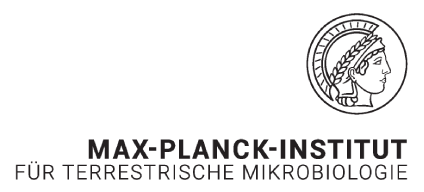Main Content
Research
Methoxydotrophic archaea
Methoxylated aromatic compounds are key components of lignin and coal and are very abundant on Earth. Therefore, it is surprising that conversion of these compounds has previously only been described for bacteria and not for archaea, although the latter have been important drivers of various biogeochemical cycles for billions of years.
In 2016, however, it was discovered that the methane-producing archaeon Methermicoccus shengliensis can grow on methoxylated compounds [1]. Methane-producing archaea, so-called methanogens, are major players in the global carbon cycle as well as main producers of the greenhouse gas methane. Therefore, it is crucial to investigate those organisms and to reveal deeper insights into their metabolisms.

Using a complementary array of physiological and -omics methods, we showed that M. shengliensis uses a bacterial-like methyl transfer system for methanogenesis with methoxylated compounds as substrates [2]. Furthermore, we concluded that the methyl group from the methoxylated compound is transferred to a methyl carrier different from that of the classic pathway using methylated compounds. This most likely leads to an altered energy metabolism and redox (im)balance during methoxydotrophic growth.
In a recent study, we showed that also the non-methanogenic archaeon Archaeoglobus fulgidus can grow on methoxylated compounds and observed atypical changes in its carbon and energy metabolism [3]. Additionally, other archaea that thrive in hydrothermal deep-sea sediments such as Bathyarchaeota, Lokiarchaeota and Verstraetearchaeota also appear to have the genetic potential for growth on methoxylated compounds. These findings together with the abundance of methoxylated compounds in natural environments suggest that methoxydotrophic archaea might play an underestimated but vital role for the global carbon cycle.

In the future, my group will investigate the unusual carbon and energy metabolism of methanogenic and non-methanogenic methoxydotrophic archaea by growth kinetics, metabolite and multi-omics analyses. We willl characterize the most important enzymes in methoxydotrophic pathways using biochemical methods. To understand the environmental role of methoxydotrophic archaea, we will survey the distribution and abundance of methoxydotrophic microorganisms in various habitats. With these studies we aim on gaining insights into the methoxydotrophic capabilities of diverse archaea, their exceptional metabolisms and the involved enzymes alongside with a greater understanding of the role of these archaea in the environment.
[1] Mayumi et al. (2016) Science 354: 222-225
[2] Kurth et al. (2021) ISME J 15: 3549–3565
[3] Welte (2021) Environ Microbiol 23: 4017-4033


